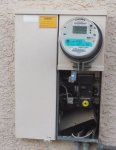Hi everyone,
So i got into a "discussion" with our engineer (i know that was my first mistake) about the 120% rule.
Scenario: We are installing a 100A PV sub panel being fed by a 70A breaker from a 225A panel board (inside garage) which in turn is being fed from a 200A service Entrance main (outside garage). The main is different in that it has no branch breaker provisions and merely feeders going to the 225A panel board.
From what I see, the 120% rule is good to go. 225A x 1.2 = 270A -200A =70A. We are putting in less than 60A (@ISC).
Our engineer is adamant about downsizing the 200A main breaker to 175 to "protect" the "bussing" going out to the utility feed. Huh? Am I missing something? I was under the impression that the 120% rule only applied to what is in between the solar breakers and the main, in this case the feeder wires and bus bar in the 225A panel board and sub. I attached some pictures for clarification.
Thanks!
So i got into a "discussion" with our engineer (i know that was my first mistake) about the 120% rule.
Scenario: We are installing a 100A PV sub panel being fed by a 70A breaker from a 225A panel board (inside garage) which in turn is being fed from a 200A service Entrance main (outside garage). The main is different in that it has no branch breaker provisions and merely feeders going to the 225A panel board.
From what I see, the 120% rule is good to go. 225A x 1.2 = 270A -200A =70A. We are putting in less than 60A (@ISC).
Our engineer is adamant about downsizing the 200A main breaker to 175 to "protect" the "bussing" going out to the utility feed. Huh? Am I missing something? I was under the impression that the 120% rule only applied to what is in between the solar breakers and the main, in this case the feeder wires and bus bar in the 225A panel board and sub. I attached some pictures for clarification.
Thanks!




